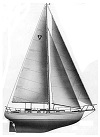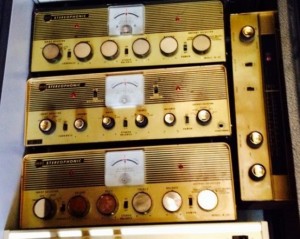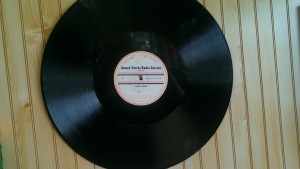

Hamlin Audio
 In exploring old audio history I often talk to guys that could reach into their pocket right that minute and retrieve a part from a 30-year-old product, as well as random parts from their current project. This pre-Memorial Day lunch was different.
In exploring old audio history I often talk to guys that could reach into their pocket right that minute and retrieve a part from a 30-year-old product, as well as random parts from their current project. This pre-Memorial Day lunch was different.
A guy walks into SpeakerLab (How many good stories could start like that? So many.) One thing led to another (Thanks, Ann!) and suddenly I was at lunch with a vintage-audio-component super collector named Patrick Roush. This guy can, right now, set up a dream audio stack with era-appropriate speakers and media. He has stacks of gear, carefully maintained and in working order. He has tubes, of course, and he has a tube tester. For a while I was happy just listening to his component/loudspeaker/media combinations. It was like he was painting a picture of the preferred audio stacks of my older brother and his frat brothers, each one different but choice.
Because we are completing a database of influential audio Retailers in the PNW post 1948, my ears perked up when Patrick described a stereo component built by H.H.Scott and sold under the brand name Hamlins Audio Workshop.
The owner of Hamlin’s was Philip Deming Hamlin (1917-2014). Mr. Hamlin’s electronic expertise bloomed during his five years of WWII where he excelled in Radio and Radar Research, rising from private to Major. He installed one of the the first cable TV systems in the world on Alki in 1949. He is also famous for inventing the cable converter box. He owned a factory named Hamlin International Corp and manufactured cable boxes and accessories. In the mid-fifties to mid sixties Mr. Hamlin sold stereo audio components, as well as manufacturing his own speakers and amplifiers. And that brings me back to the lunch with Patrick.
After introducing me to Hamlin’s equipment (some of it made by H.H. Scott), the conversation took a meditative turn when Patrick commented about the huge societal effect of the return of the soldiers of WWII. We also touched on Vietnam; which was a factor at the start of many of the audio industry careers we have been documenting. In addition, audio components came back to the states in great numbers as the Vietnam vets returned (Sansui, anyone?) Vets from both wars came back and changed the landscape with their new technical skills and interests, war-related advances in communication technologies, and the G.I. Bill.
 As we made our way out of Salmon Bay Cafe Patrick showed me where the cafe had added on during the 1990s. We turned to find the exit and bam! in front of us on the wall hung a 16″ disc labelled US War and Navy Departments. It was a WWII-era,old format record. I was suddenly appreciating Memorial Day in a new way. We celebrate veterans for their service, but we can also appreciate the many good things and opportunities they created when they got back. And audio industry history is everywhere.
As we made our way out of Salmon Bay Cafe Patrick showed me where the cafe had added on during the 1990s. We turned to find the exit and bam! in front of us on the wall hung a 16″ disc labelled US War and Navy Departments. It was a WWII-era,old format record. I was suddenly appreciating Memorial Day in a new way. We celebrate veterans for their service, but we can also appreciate the many good things and opportunities they created when they got back. And audio industry history is everywhere.
For more about Philip D Hamlin The Old CATV Equipment Museum














Colleen,
It is great to see your blog. Brings back a lot of memories. Regarding Hamlin, I remember as a kid I use used to visit his retail store in what is now Bell town on 3rd or 4th Avenue. I remember the Hamlin amps, which were very cool stuff back in the mid 60s. Bill Wood the original Kenwood rep here in the PacNW told me that those amps were built by Trio that was later to become Kenwood.
Dale, we are throwing a listening party in September with Hamlin equipment and speakers included! I will make sure to send you the date (plus it will be posted here) And thanks for the additional Hamlin material!
Nice story. What a horrible outcome for Mr. Hamlin Sr. Just a few years ago, I was given a Hamlin’s integrated amp, FM tuner and pair of speakers by a former patient. I am quite familiar with vintage tube gear-I had never heard of this brand. Never plugged them in so unsure if they are functional or not. Cool level meter on the amp. Use the speakers for surroud sound. I think they are partially horn-loaded. The amp and tuner do not look American made. Thanks!